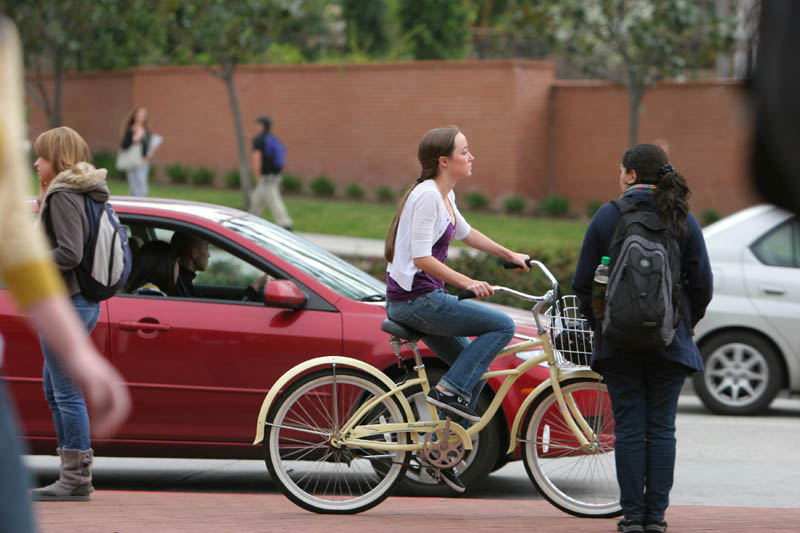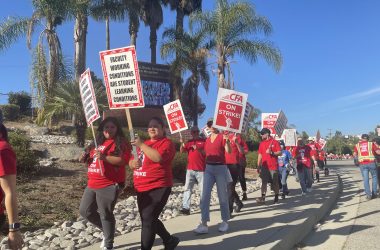Reaching Cal State Long Beach can be considered a competition between cyclists, pedestrians and motorists. The CSULB Cyclists are hoping to make the campus more cycling-friendly.
“I cycle for transportation, and zipping past pedestrians or cruising by cars stuck in gridlock is definitely satisfying,” said Sasha Harvey, a freshman marine biology major and CSULB Cyclists member.
Physical Planning Director Susan Brown is working hard to develop bike paths on campus as well as researching the feasibility of campus improvements for cyclists.
In conjunction with CSULB University Police and Parking and Transportation Services, Brown will be working with a transportation consultant from the bicycle and pedestrian planning division at Fehr & Peers Transportation Consultants, a transportation planning and traffic engineering consultant firm, in order to develop plans for bike paths and to avoid conflict between pedestrians and vehicles.
“CSULB has been working with Fehr & Peers for a long time,” Brown said.
Fehr & Peers is conducting a study on CSULB’s campus architecture for the placement of bike paths, according to Danny Yost Jr., the transportation planner and engineer.
“There are no established bike paths on campus now, but we expect the study to start within the next 60 days,” Brown said.
Fehr & Peers conducted all the research on CSULB’s roadway geometries, according to Brown.
“This is a comprehensive city-wide transportation project to improve bikeway and pedestrian access,” said Elissa Thomas, the rideshare coordinator from Sustainable Transportation Programs and Services, who is also working on the project.
According to Thomas, a new bike lane is planned for construction along Atherton Street. Prior to any major planning, however, CSULB Cyclists need to consult with the student population about the idea, said Kevin Flaherty, a geography graduate student and creator of the cyclist organization.
Flaherty started the organization in spring 2008 with a few other people because there was no voice on campus to speak about the issues cyclists face, Flaherty said. The group consists of more than 200 students and faculty, and they meet every other week on Mondays in the USU.
The club offers classes on safety and security, as well as beginner cyclist classes. CSULB Cyclists want to create an advisory committee for campus administrators to discuss future additions to parking facilities, since CSULB needs to be concerned about pedestrians, runners, cyclists, and the disabled, Flaherty said.
“It is a lot cheaper for the school to install bike racks than to build parking structures,” said Andy Pekema, a senior mechanical engineering major. “The projected price for Parking Structure 3 was $23 million to $27 million, and that could buy a lot of bike racks, and even bikes for students.”
Thomas expressed some concern over bikers’ safety.
“My top concern and reason why I have been advocating for bike lanes, racks, air pumps and signage is safety,” Thomas said.
Some students take issue with other trepidations.
“My biggest worry is being arrested,” Flaherty said. “I have been handcuffed twice for riding a bike and both times the judge threw my case out.”
The study will be inclusive to safety, Brown said.
“The campus and state police need to be made aware of proper bicycle usage and how bicycles have as much right to the road as any other,” Flaherty said.
For reduced bike theft on campus, students should get their bikes licensed at the local fire department, according to the February 2009 press release by the Cyclists.
CSULB Rideshare, BikeStation and Alta. Cruz & Associates are working together to recruit and train volunteers to examine specific locations throughout the city and determine the baseline count and survey data this past fall, according to Thomas.
Brown does not know how long the process will take.
Long Beach is the first home to BikeStation in the U.S., which is a program to improve urban environments for cyclists by placing racks close to metro stops, according to Thomas. BikeStation, according to its website, design and operate bike transportation centers.
According to Flaherty, because of the state of California’s budget, no funds are currently available to build the bike paths.
CSULB Rideshare hopes to see Long Beach as one of the most bike-friendly cities in the nation in the near future. It has been working on this goal since 2008, according to Thomas.
Davis, Calif., Portland, Ore., and Boulder, Colo. are the top three bike-friendly cities, as ranked the League of American Bicyclists. California is ranked fourth out of the 50 states.
Personnel from Alta. Cruz & Associates, Sumire Gant from the City of Long Beach Transportation Planning and Programs, BikeStation and Brown are all working together to see more bikers than motorists at CSULB, Thomas said.
Gant gave a presentation to CSULB Cyclists at their most recent club meeting about her involvement in the bike path project. They are looking for areas that need improvement, and documenting that need in order to make improvements by adding bike lanes and bike boulevards, Thomas said. They will then go back and survey and perform a headcount again to compare the data versus the baseline data.
“Bikeways on campus are being carefully planned to interface with the city’s new bike lanes providing dedicated bike access to the campus, and also to interface seamlessly with the internal layout of our campus — existing architecture, landscape, parking, roadways, and pedestrian pathways,” Thomas said.
The bike lane on Atherton Street is already interfaced with the city’s new bike paths, Brown said.
Both Thomas and Flaherty said that any changes made would have no impact on student fees.
Most students who cycle to campus live nearby, and a few cyclists come from the Blue Line, according to Flaherty.
“The only issue that bothers me really is that there are too few bike lanes near campus,” he said.
Many cyclists ride for both health and environmental reasons.
“If five percent of all CSULB students and staff used a sustainable mode of transportation, such as bicycling, together we could reduce 14 tons of carbon emissions daily, for each five miles traveled,” Thomas said.
Pekema said “rising obesity rates and global warming can be significantly decreased by cycling.”




